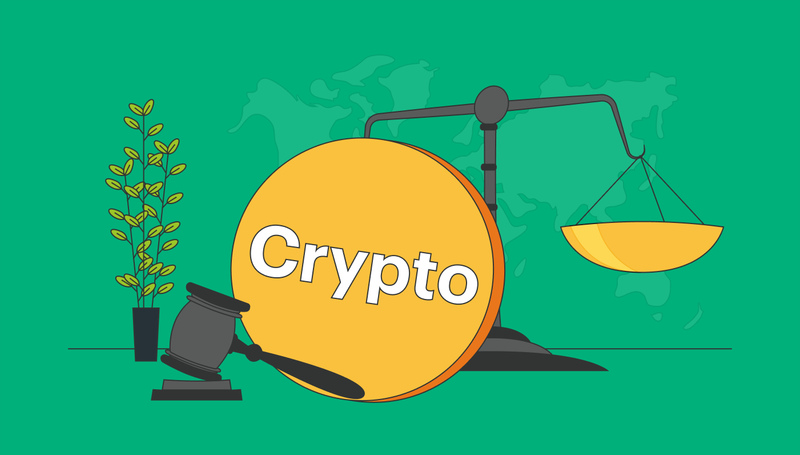Top Cryptocurrency Trends in 2023

2023 marks a pivotal moment for cryptocurrency. The industry is witnessing remarkable growth and transformation across various sectors. And as the world embraces the potential of digital assets, we explore the top cryptocurrency trends shaping the industry in 2023. That includes institutional adoption, regulatory developments, the shift to proof-of-stake, and much more.
In this guide, we explore these trends and their implications for the future of cryptocurrencies in detail. And we cover everything in simple English and with examples.
Best Cryptocurrency Trends Summary
Don’t have time for our full guide? Read the short version instead:
- Institutional adoption of cryptocurrencies is surging, with major financial players incorporating digital assets into their investment portfolios.
- Central Bank Digital Currencies (CBDCs) gain momentum as several countries explore and launch their own digital versions of fiat currency.
- Decentralized Finance (DeFi) continues to flourish, witnessing increased adoption and offering innovative financial services.
- Non-Fungible Tokens (NFTs) dominate the crypto market, extending beyond the art and gaming industries to tokenize various digital content.
- Regulatory developments shape the industry, with countries like Europe introducing the Markets in Crypto-Assets (MiCA) regulation and others exploring different regulatory approaches.
How Crypto Is Changing in 2023
In 2023, the cryptocurrency industry is experiencing transformative changes reshaping how we perceive and interact with digital assets. These developments are driven by technological advancements, increased institutional participation, regulatory maturation, and growing awareness among the general public. Therefore, we compiled some key aspects of how crypto is changing in 2023.
- Maturing market: The cryptocurrency market has evolved significantly and reached a maturity level that attracts institutional investors. With increased regulatory clarity, traditional financial players are more confident in venturing into the crypto space, leading to a broader and more diverse investor base.
- User-friendly interfaces: The user experience in the crypto industry has seen substantial improvements. User-friendly interfaces and simpler onboarding processes have made it easier for beginners to enter the market and participate in activities like trading, staking, and lending.
- Financial inclusion: Cryptocurrencies provide unbanked and underbanked populations access to financial services. In 2023, more people from developing regions are leveraging cryptocurrencies to access remittances, loans, and other financial products that were previously unavailable.
- Tokenization of assets: Real estate, art, commodities, and other traditional, real-world assets are now available as digital tokens on blockchain platforms. This facilitates fractional ownership and enhances liquidity in previously illiquid markets.
- Cross-border payments: Cryptocurrencies offer faster and more cost-effective alternatives to traditional remittance methods. Blockchain technology reduces intermediary fees and transaction times, making cross-border transactions more efficient.
- Enhanced security measures: Blockchain networks and exchanges implement robust security protocols to protect user funds and personal information from cyber threats.
- Regulatory compliance: Governments and financial authorities worldwide are establishing clear guidelines for crypto-related activities to protect investors and ensure market integrity.
Top Cryptocurrency Trends in 2023
Today, several transformative trends are shaping the industry. These trends reflect the growing interest in cryptocurrency and the changing landscape of digital finance. Below are the best cryptocurrency trends in 2023.
Mass Adoption by Institutions
In 2023, cryptocurrencies are experiencing a surge in institutional adoption. Major financial players incorporate digital assets into their investment portfolios, recognizing their potential as a hedge against inflation and fiat currency devaluation. As a result, this influx of institutional capital has increased market liquidity and enhanced market stability, bolstering overall investor confidence.
Central Bank Digital Currencies (CBDCs) Proliferation
CBDCs have gained significant momentum in 2023, with several countries piloting or launching their digital versions of fiat currency. These initiatives aim to provide efficient and secure means of payment, potentially transforming traditional banking systems.
Hence, it may drive further interest and usage of cryptocurrencies, especially in economies where these digital assets complement existing financial infrastructures.
Decentralized Finance (DeFi) Continues to Flourish
Decentralized Finance (DeFi) remains one of the most transformative sectors within the cryptocurrency space. In 2023, DeFi platforms are witnessing increased adoption, offering innovative financial services such as lending, borrowing, staking, and yield farming. The Total Value Locked (TVL) in DeFi protocols has reached new heights, indicating growing trust and confidence in these platforms.
Nevertheless, regulatory scrutiny and security concerns challenge the sector’s growth, demanding a focus on user protection and compliance.
Rise of Non-Fungible Tokens (NFTs)
NFTs have become a dominant force in the crypto market during 2023. These unique digital assets expanded beyond the art and gaming industries, finding applications in virtual events, ticketing, intellectual property rights, and more.
The NFT frenzy has led to the tokenization of digital content, giving creators and artists newfound ways to monetize their work. As the trend persists, the industry will likely witness more creative and sustainable use cases for NFTs.
Interoperability and Layer 2 Scaling Solutions
Addressing scalability concerns, 2023 has seen notable progress in layer 2 scaling solutions and interoperability protocols. These advancements aim to enhance transaction throughput and reduce fees. Layer 2 solutions like the Lightning Network for Bitcoin and Ethereum’s integration with Layer 2 platforms showcase promising results.
Additionally, cross-chain bridges facilitate seamless asset transfers between different blockchain ecosystems, fostering greater efficiency and accessibility.
Environmental and Energy Concerns
Environmental consciousness has become a pivotal trend in 2023 as the crypto industry addresses energy consumption concerns and their impact. As a result, many projects and networks are actively exploring greener alternatives, such as transitioning from proof-of-work (PoW) to more energy-efficient consensus mechanisms like proof-of-stake (PoS).
Environmental sustainability is now a crucial consideration for users and investors alike.
Proof-of-Stake (PoS)
Ethereum switched from the PoW consensus mechanism to the PoS in 2022 to address scalability and energy consumption concerns. By transitioning from PoW to PoS consensus, cryptos seek to increase transaction throughput, reduce fees, and lower the network’s environmental impact.
Taxation and Regulations
With increased crypto adoption, tax authorities are closely monitoring cryptocurrency transactions. In 2023, governments are introducing clearer tax guidelines to ensure accurate reporting and taxation of cryptocurrency gains. Therefore, cryptocurrency users and businesses must comply with taxation requirements to avoid legal consequences.
Furthermore, governments worldwide are actively working on regulatory frameworks for cryptocurrencies. The focus is on providing legal clarity, protecting investors, and mitigating money laundering and fraud risks. Hence, regulatory developments could foster mainstream adoption by providing a secure and transparent environment for crypto-related activities.
Examples:
- Europe’s MiCA regulation: In 2023, the European Commission announced the Markets in Crypto-Assets (MiCA) regulation. This framework aims to regulate and provide legal clarity for cryptocurrencies and digital assets across the European Union. MiCA proposes a harmonized regulatory approach to enhance investor protection and reduce crypto activity risks like market abuse and fraudulent schemes. The regulation will impose stricter rules for issuers and service providers, promoting the integrity and stability of the European crypto market.
- US crypto tax reporting: In the United States, the Internal Revenue Service (IRS) has been increasingly focused on crypto tax compliance in 2023. The IRS has issued guidelines clarifying the reporting requirements for cryptocurrency transactions, including a specific question on tax forms asking taxpayers about their crypto holdings and activities. Also, failure to accurately report crypto gains and income could lead to penalties or legal consequences.
- El Salvador’s Bitcoin adoption: El Salvador made history by becoming the first country to adopt Bitcoin as a legal tender. The nation passed the “Bitcoin Law,” thus recognizing Bitcoin as a currency alongside the US dollar. The law aims to boost financial inclusion and promote economic development by facilitating cross-border remittances and encouraging digital financial services.
- China’s ongoing crypto crackdown: China continues its strict stance on cryptocurrencies, banning all crypto-related activities, including trading, mining, and Initial Coin Offerings (ICOs). The authorities are particularly concerned about speculative trading and financial instability risks. But despite the crackdown, China has shown interest in exploring blockchain technology for other applications.
- Singapore’s licensing requirements: Singapore’s financial regulator, the Monetary Authority of Singapore (MAS), introduced a licensing framework for cryptocurrency exchanges. Under this regulation, crypto exchanges in Singapore must obtain a license and comply with anti-money laundering (AML) and counter-terrorism financing (CTF) requirements.
Frequently Asked Questions
Find out more about the top 8 cryptocurrency trends in 2023.
What is the future of cryptocurrencies in 2023?
The future of cryptocurrencies in 2023 appears promising, with increasing institutional adoption, CBDCs proliferation, and advancements in DeFi and NFTs. However, regulatory developments and environmental concerns also shape the industry’s trajectory.
How are cryptos being regulated globally?
In 2023, many countries are actively developing cryptocurrency regulatory frameworks to provide legal clarity and protect investors. Governments focus on issues like anti-money laundering (AML) and investor protection while encouraging innovation in the blockchain space.
What role do NFTs play in the cryptocurrency space?
NFTs (Non-Fungible Tokens) represent unique digital assets and have found applications in art, collectibles, gaming, and virtual real estate. They enable true ownership and provenance of digital items, creating new opportunities for creators and collectors.
What are privacy coins, and why are they gaining popularity?
Privacy coins like Monero and Zcash offer enhanced transaction privacy and anonymity, making them appealing to users concerned about their digital footprints. These coins use advanced cryptographic techniques to shield transaction details from public view.
How are stablecoins being used in the crypto market?
Stablecoins bridge traditional finance and the crypto market, as they are pegged to fiat currencies or other assets. They provide stability amid the volatility of cryptocurrencies and facilitate fast and low-cost cross-border transactions.
Cryptocurrency Trends – Final Words
The cryptocurrency landscape in 2023 is dynamic and continually evolving. Key industry trends include institutional adoption, CBDCs, DeFi, NFTs, scalability solutions, and environmental concerns. As the crypto space matures, it’s looking more and more likely that governments will develop regulatory frameworks, contributing to increased stability and mainstream acceptance.
However, it is essential to remain vigilant about potential risks and challenges, ensuring a sustainable and prosperous future for the cryptocurrency market.





